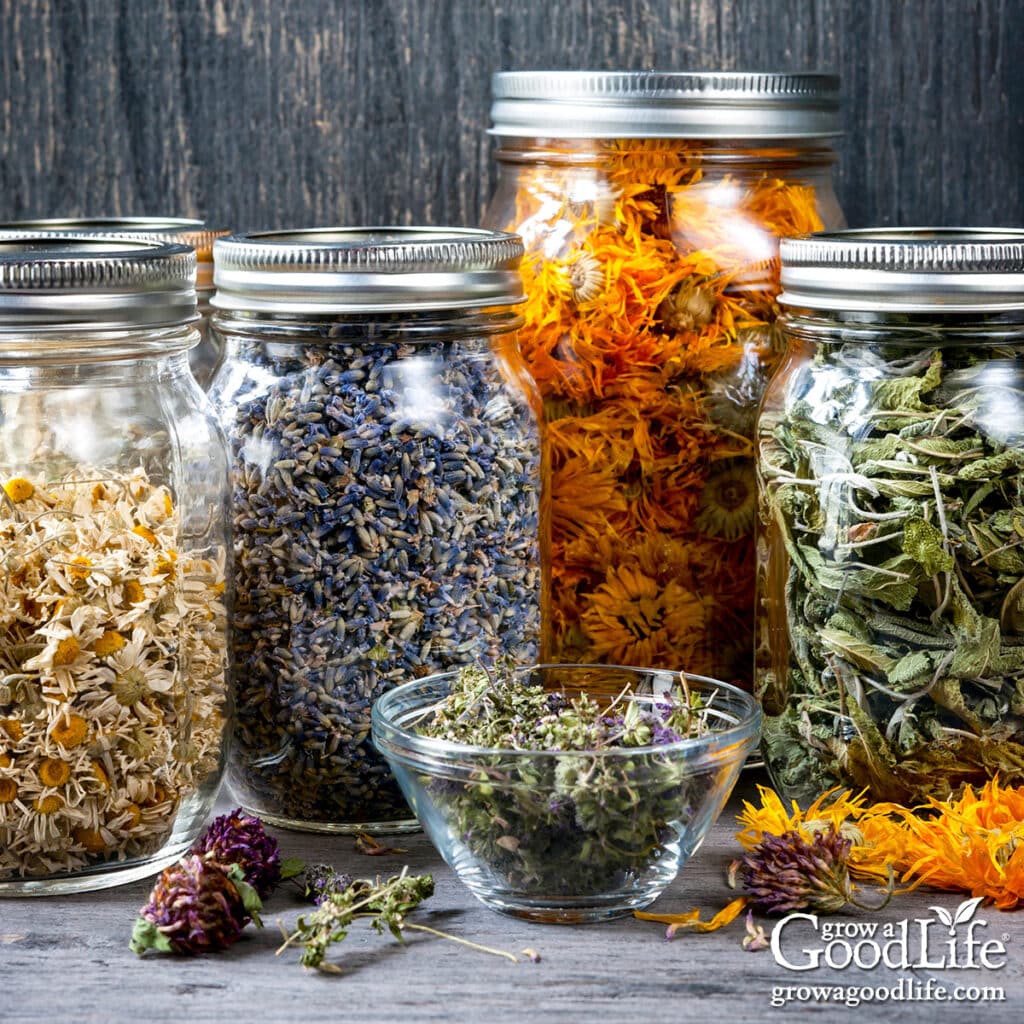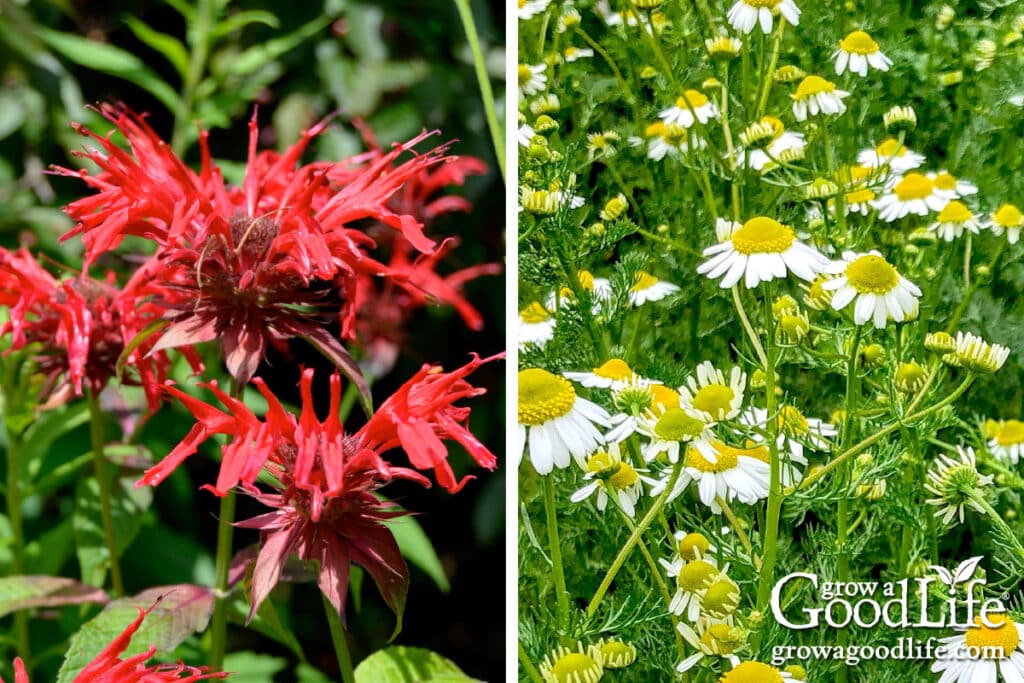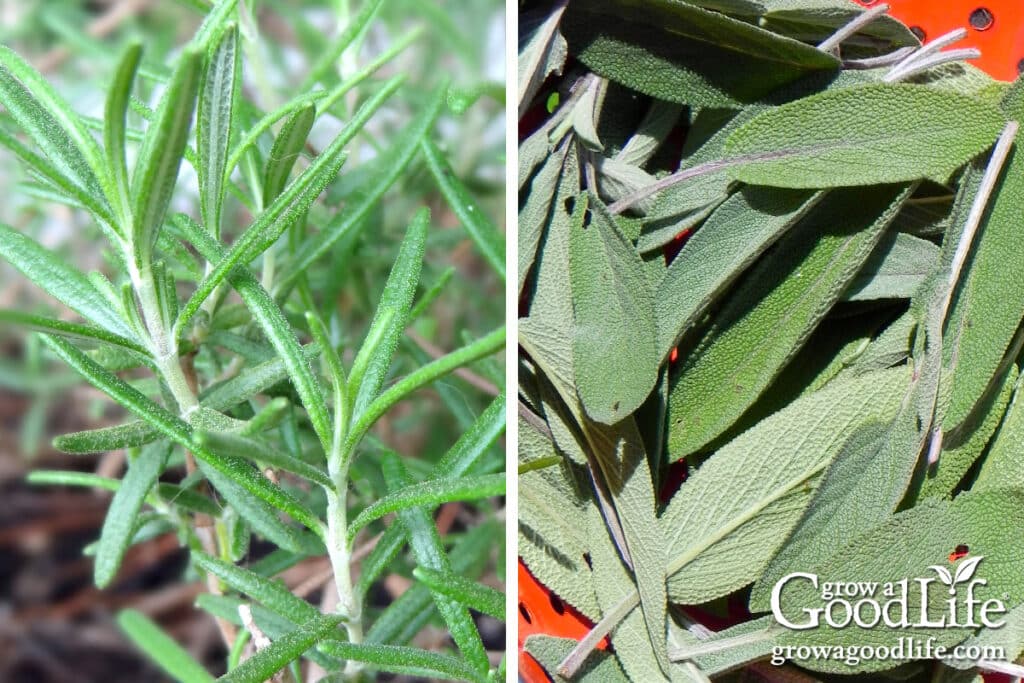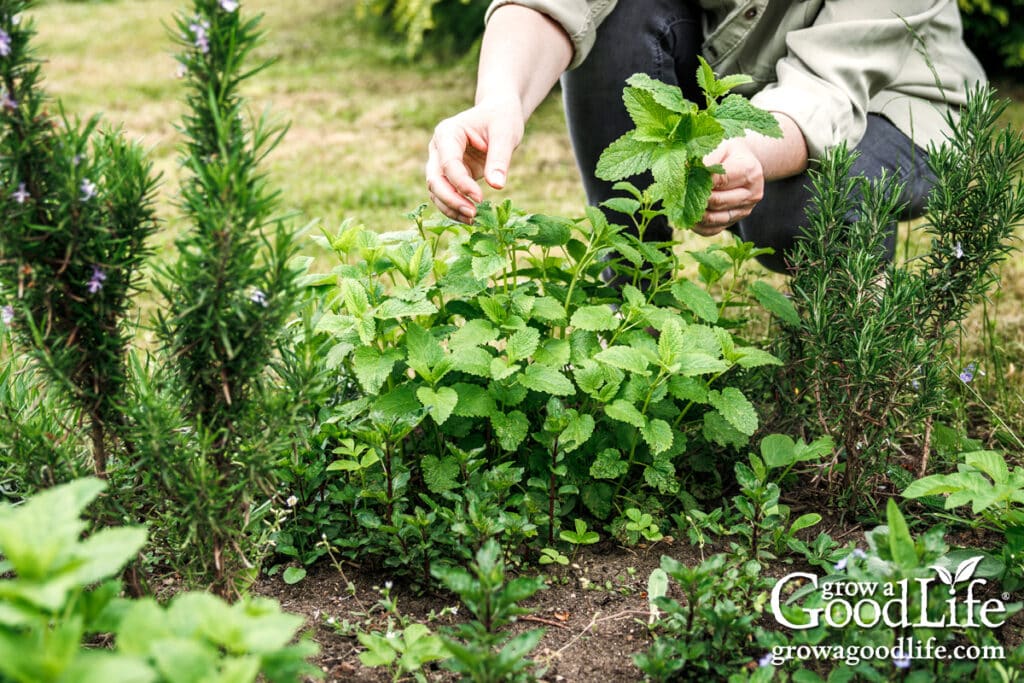How to Grow an Herbal Tea Garden
This post may contain affiliate links, which means that I may receive a commission if you make a purchase using these links. As an Amazon Associate I earn from qualifying purchases.
If you enjoy herbal tea, you will love growing and preserving your own. In this guide, we’ll explore how to cultivate your own herbal tea garden, from selecting the perfect herbs to nurturing them to maturity, harvesting, drying, and finally, enjoying your own homegrown herbal tea.

Have you ever wanted to grow your own herbal tea? Imagine harvesting and preserving your own herbs for tea and brewing them into a soothing cup of tea infused with natural flavors and aromas. Welcome to the world of herbal tea gardening, where the simple act of cultivating herbs can transform your daily tea ritual into a vibrant, sensory experience.
Growing an herbal tea garden not only provides a convenient and sustainable source of ingredients but also offers a plethora of benefits for both body and soul. From the calming effects of chamomile to the invigorating burst of peppermint, each herb carries its own unique blend of flavors and therapeutic qualities.
In this guide, we’ll share tips for cultivating your own herbal tea garden, from choosing the perfect herbs and selecting the right growing location to planting and nurturing them to maturity, harvesting, drying, and finally, enjoying the fresh flavor of brewed tea.
15 Herbs You Can Grow for Tea
Are you wondering which herbs are ideal for planting an herbal tea garden? When it comes to crafting the perfect cup of herbal tea, the possibilities are endless. Here, we’ll explore some of the most popular herbs used in tea-making and delve into their distinctive flavors, potential health benefits, and growing tips.
Bee Balm (Monarda)
- Flavor Profile: Bee balm tea offers a citrusy, minty flavor with floral undertones and a hint of spice.
- Health Benefits: Bee balm is prized for its antimicrobial and anti-inflammatory properties, making it valuable for supporting immune health and relieving sore throats and coughs. It’s also believed to aid digestion and promote relaxation.
- Hardiness: Zones 4 to 9.
- Sun: Full sun to partial shade.
- Soil: Moist, well-drained soil.
- How to Grow: Start from seeds or transplants. Deadhead spent blooms to encourage repeat flowering. Learn more about how to grow, harvest, and preserve bee balm.
- Harvest: Harvest leaves and flowers as needed throughout the growing season.
Calendula (Pot Marigold)
- Flavor Profile: Calendula tea offers a mild, slightly spicy flavor with subtle floral notes.
- Health Benefits: Calendula is revered for its anti-inflammatory and antimicrobial properties, making it a valuable herb for supporting skin health and boosting immune function.
- Hardiness: Zones 2 to 11.
- Sun: Full sun to partial shade.
- Soil: Well-drained soil with moderate fertility. It can tolerate a wide range of soil types but thrives in loamy, slightly alkaline soil.
- How to Grow: Start from seeds or transplants. Deadhead spent blooms to encourage repeat flowering.
- Harvest: Harvest flowers when they are fully open and vibrant in color.
Chamomile
- Flavor Profile: Both Roman chamomile and German chamomile are renowned for their delicate, floral aroma and subtle apple-like flavor.
- Health Benefits: Known for its calming properties, chamomile tea is often enjoyed before bedtime to promote relaxation and aid in sleep. It’s also prized for its soothing effects on the digestive system.
- Hardiness: Zones 4 to 8.
- Sun: Full sun.
- Soil: Well-drained, loamy soil.
- How to Grow: Direct sow seeds or transplant seedlings. German chamomile self-seeds readily. For more information, check out our chamomile growing guide.
- Harvest: Harvest flowers when they are fully open, and petals are slightly turned backward.

Echinacea (Coneflower)
- Flavor Profile: Echinacea tea offers a slightly bitter, earthy flavor with hints of sweetness and a tingling sensation on the tongue.
- Health Benefits: Echinacea is prized for its immune-boosting properties, helping to reduce the severity and duration of colds and flu. It’s also believed to have anti-inflammatory and antioxidant effects.
- Hardiness: Zones 3 to 9.
- Sun: Full sun to partial shade.
- Soil: Well-drained, fertile soil.
- How to Grow: Start from seeds or transplants. Provide good air circulation to prevent mildew.
- Harvest: Harvest flower heads when fully open and petals are vibrant.
Fennel
- Flavor Profile: Fennel tea offers a mild, sweet licorice-like flavor with hints of anise and citrus.
- Health Benefits: Fennel is prized for its digestive benefits, helping to alleviate bloating, gas, and indigestion. It’s also believed to support respiratory health and promote relaxation.
- Hardiness: Zones 4 to 9.
- Sun: Full sun.
- Soil: Well-drained, fertile soil.
- How to Grow: Start from seeds or transplants. Provide adequate spacing as fennel can grow quite large.
- Harvest: Harvest leaves and seeds as needed throughout the growing season.
Holy Basil (Tulsi)
- Flavor Profile: Holy basil tea offers a slightly spicy, clove-like flavor with hints of citrus and peppery undertones.
- Health Benefits: Holy basil, revered as a sacred plant in Ayurvedic medicine, is prized for its adaptogenic properties, helping the body adapt to stress and promote balance. It’s also known for its immune-boosting, anti-inflammatory, and antioxidant effects.
- Hardiness: Zones 9 to 11 (can be grown as an annual in colder climates).
- Sun: Full sun.
- Soil: Well-drained, fertile soil.
- How to Grow: Start from seeds or transplants. Protect from frost in colder climates.
- Harvest: Harvest leaves as needed throughout the growing season.
Lavender
- Flavor Profile: Lavender tea exudes a fragrant floral aroma and a subtle, slightly sweet flavor with hints of pine and citrus.
- Health Benefits: Renowned for its calming and soothing properties, lavender tea can help alleviate anxiety, promote relaxation, and improve sleep quality. It’s also prized for its antioxidant and anti-inflammatory properties.
- Hardiness: Zones 5 to 8.
- Sun: Full sun.
- Soil: Well-drained, sandy or loamy soil.
- How to Grow: Propagate from cuttings or start from nursery plants. Prune after flowering to encourage bushiness.
- Harvest: Harvest flower spikes just as the buds begin to open for the best flavor and fragrance.
Lemon Balm
- Flavor Profile: With a lemony, citrus-infused flavor and subtle hints of mint, lemon balm tea offers a bright and uplifting sensory experience.
- Health Benefits: Lemon balm is revered for its calming and mood-lifting effects, making it an ideal choice for reducing stress and promoting a sense of well-being. It’s also known for its potential to support cognitive function and improve sleep quality.
- Hardiness: Zones 5 to 9.
- Sun: Partial shade to full sun.
- Soil: Lemon balm will tolerate a variety of soil conditions, although it prefers rich, moderately moist soil.
- How to Grow: Sow seeds or transplants. Cut the plant back after it blooms, and it will produce fresh growth. Check out our lemon balm growing guide for more information.
- Harvest: For the strongest flavor, harvest before the plant blooms. Cut leaves and stems as needed throughout the growing season.
Lemon Verbena
- Flavor Profile: Lemon verbena tea offers a bright, citrusy flavor with a refreshing, herbal undertone.
- Health Benefits: Lemon verbena is prized for its calming and digestive properties, making it ideal for soothing upset stomachs and promoting relaxation. It’s also believed to have antioxidant and anti-inflammatory effects.
- Hardiness: Zones 9 to 11 (can be grown as an annual in colder climates).
- Sun: Full sun.
- Soil: Well-drained, sandy or loamy soil.
- How to Grow: Propagate from cuttings or start from nursery plants. Protect from frost in colder climates.
- Harvest: Harvest leaves as needed throughout the growing season.
Mint
- Flavor Profile: Refreshingly minty with a cooling sensation, mint tea invigorates the senses and awakens the palate. Many cultivars are available, each with a unique flavor profile and characteristics, including peppermint, spearmint, chocolate mint, pineapple mint, and apple mint.
- Health Benefits: Mint tea is prized for its ability to alleviate digestive discomfort, ease tension headaches, and freshen breath. Its menthol content provides a natural pick-me-up without caffeine.
- Hardiness: Zones 4 to 9.
- Sun: Partial shade to full sun.
- Soil: Moist, well-drained soil.
- How to Grow: Plant seedlings or propagate from cuttings or root divisions from an established plant for the best flavor. Be sure to taste the leaves first. Some plants can be bitter. Grow in containers to prevent spreading.
- Harvest: Cut stems just before flowering for the best flavor.

Rose Petals or Rose Hips
- Flavor Profile: Rose tea offers a delicate floral aroma and a subtly sweet flavor with hints of fruitiness.
- Health Benefits: Rose petals are rich in antioxidants and vitamin C, making them valuable for boosting immune health and promoting radiant skin. Rose hips, the fruit of the rose plant, are particularly high in vitamin C and may help support immune function and improve digestion.
- Hardiness: Depends on the rose variety.
- Sun: Full sun.
- Soil: Well-drained, fertile soil.
- How to Grow: Choose varieties known for their fragrance and edible petals. Deadhead spent blooms to encourage repeat flowering.
- Harvest: Harvest fresh petals as they open, avoiding those treated with pesticides. Harvest rose hips after the first frost when they turn red and are fully ripe.
Rosemary
- Flavor Profile: Rosemary tea boasts a robust, pine-like flavor with earthy undertones and a refreshing, herbal aroma.
- Health Benefits: Rosemary is revered for its cognitive-enhancing properties, helping to improve memory, focus, and mental clarity. It’s also known for its antioxidant and anti-inflammatory effects, making it a valuable addition to your herbal tea repertoire.
- Hardiness: Zones 7 to 10.
- Sun: Full sun.
- Soil: Well-drained, sandy or loamy soil.
- How to Grow: Propagate from cuttings or start from nursery plants. Prune regularly to maintain shape and promote new growth. Check out our rosemary growing guide for more details.
- Harvest: Cut sprigs as needed, avoiding overharvesting from one area to encourage regrowth.
Sage
- Flavor Profile: Sage tea offers a savory, slightly bitter taste with a hint of mint and earthiness, depending on the variety. Common sage has a strong, distinct flavor with hints of eucalyptus and camphor, while pineapple sage has a slight fruity sweetness.
- Health Benefits: Sage is prized for its antimicrobial and anti-inflammatory properties, making it an excellent choice for supporting immune health and relieving sore throats. It’s also believed to enhance cognitive function and aid in digestion.
- Hardiness: Zones 5 to 8.
- Sun: Full sun.
- Soil: Well-drained, fertile soil.
- How to Grow: Start from seeds or cuttings. Prune after flowering to encourage bushiness. Learn more with our full growing guide: How to Grow Sage.
- Harvest: Harvest leaves as needed, avoiding excessive pruning to maintain plant health.

Stevia
- Flavor Profile: Stevia leaves have a sweet flavor with a slightly herbal and licorice-like undertone, particularly in raw form.
- Health Benefits: Stevia is a natural, zero-calorie sweetener that can be used as a sugar substitute in teas and other beverages. When brewed into tea, stevia imparts a satisfying sweetness without sugar’s calories or glycemic impact, making it an excellent choice for those looking to reduce their sugar intake or manage blood sugar levels.
- Hardiness: Zones 2 to 11.
- Sun: Full sun to partial shade.
- Soil: Well-drained, fertile soil with good moisture retention.
- How to Grow: Start from seeds or transplants.
- Harvest: Harvest leaves as needed throughout the growing season. For the best flavor, harvest leaves before the plant flowers.
Thyme
- Flavor Profile: Thyme tea boasts a warm, herbaceous flavor with hints of earthiness reminiscent of its culinary use. Lemon thyme has a citrusy, lemon-like flavor and aroma.
- Health Benefits: Thyme is revered for its potent antimicrobial and antiseptic properties, making it a valuable ally in fighting infections and supporting respiratory health. It’s also rich in antioxidants and may help improve digestion and relieve coughs and congestion.
- Hardiness: Zones 5 to 9.
- Sun: Full sun.
- Soil: Well-drained, sandy or loamy soil.
- How to Grow: Start from seeds or cuttings. Prune regularly to encourage bushiness and prevent legginess. Check out our thyme growing guide for more information.
- Harvest: Cut stems as needed, avoiding excessive pruning to maintain plant vigor.

Tips for Planting Your Herbal Tea Garden
Creating an herb garden begins with some planning. From selecting the perfect location to arranging your herbs for optimal growth, each step plays an important role in the garden’s success.
Selecting the Right Location
When choosing a location for your herbal tea garden, consider several factors:
- Sunlight: Most herbs thrive in full sun, so select a spot that receives at least 6 to 8 hours of sunlight per day. However, some herbs, like lemon balm and mint, can tolerate partial shade.
- Soil Quality: Herbs prefer well-drained soil with good fertility. Ensure the soil is loose, crumbly, and rich in organic matter. Consider amending your soil with compost or other organic materials if it is heavy or compacted.
- Drainage: Proper drainage is crucial to prevent waterlogging, which can lead to root rot and other issues. Avoid low-lying areas where water tends to accumulate and ensure that the soil drains well after rain or watering.
Choosing Containers or Planting Directly in the Ground
When it comes to growing herbs for tea, you have two main options: planting directly in the ground or using containers. Here are the pros and cons of each:
Planting Directly in the Ground:
Pros:
- Provides ample space for herbs to spread out and grow to their full potential.
- Allows herbs to establish deep root systems, enhancing their resilience and drought tolerance.
Cons:
- Requires adequate garden space, which may be limited for some gardeners.
- May be less suitable for gardeners with poor soil quality or drainage issues.
Using Containers:
Pros:
- Ideal for gardeners with limited space, such as balconies, patios, or small yards.
- Offers greater control over soil quality, drainage, and placement, allowing you to create optimal growing conditions for your herbs.
Cons:
- Containers may require more frequent watering, as they tend to dry out more quickly than garden beds.
- Some herbs, particularly those with aggressive growth habits like mint, may become invasive if planted in containers without proper containment.
Planning the Layout
When planning your herbal tea garden layout, it’s essential to consider the growth habits and perennial nature of certain herbs. Perennial herbs, such as thyme and lemon thyme, return year after year, so allocate space accordingly and plan for their long-term presence in your garden.
Additionally, be cautious when growing herbs that are part of the mint family, such as peppermint and lemon balm. Mint varieties are notorious for their vigorous growth and spreading tendencies, often becoming invasive if not contained. To prevent mint from taking over your garden, consider growing it in containers or designated areas where its spread can be controlled.
By taking these factors into account during the planning stage, you can create a well-organized and manageable herbal tea garden that will thrive for years to come.
Once you’ve decided on the type of herbs, location, and planting options for your herbal tea garden, it’s time to plan the layout. Consider the following tips:
Arrange herbs based on their growth habits and compatibility
Some herbs, like rosemary and thyme, prefer drier conditions and can be grouped together, while others, like basil and mint, thrive in moist, fertile soil. Consider the space requirements and growth habits of each herb when planning your layout to ensure they have room to spread out and thrive.
Incorporate companion planting
Companion planting involves growing compatible plants together to maximize growth, deter pests, and improve flavor. For example, planting aromatic herbs like lavender or bee balm alongside vegetables can help repel pests and attract beneficial insects.
Create designated zones
Consider creating designated zones or themed areas within your herbal tea garden. For example, you could dedicate one area to relaxing herbs like chamomile and lemon balm, while another area could feature invigorating herbs like peppermint and rosemary. This not only adds visual interest but also makes it easier to care for and harvest your herbs.
By carefully selecting the right location, choosing the appropriate containers or planting directly in the ground, and planning the layout of your herbal tea garden, you can create an enchanting and bountiful oasis that will delight your senses and nourish your body and soul.
Planting and Caring for Your Herbs
Before diving into the care of your herbal tea garden, it’s essential to establish your herbs, whether from seeds or transplants.
Starting Herbs from Seed:
- Choose high-quality seeds from a reputable supplier, ensuring they are fresh and viable.
- Start seeds indoors according to the number of weeks indicated on the seed package before your last expected frost date in your area. This article, 10 Steps for Starting Seeds Indoors Under Lights, explains more details.
- Once seedlings have developed several sets of true leaves and the risk of frost has passed, harden off the seedlings by gradually exposing them to outdoor conditions before transplanting them into the garden.
Transplanting Seedlings:
- Purchase healthy seedlings from a nursery or garden center, or grow your own from seeds indoors.
- Choose a planting site that meets your herbs’ sunlight, soil, and drainage requirements.
- Before transplanting, water the seedlings thoroughly to help minimize transplant shock.
- Dig a hole slightly larger than the seedling’s root ball and gently loosen the roots before placing the seedling in the hole.
- Backfill with soil, firming it gently around the base of the seedling, and water thoroughly to settle the soil.
Caring for the Plants
Now that your herbs are planted, let’s explore how to care for them to ensure optimal growth and harvest.
Watering
Herbs have varying water needs depending on their species and growing conditions. Some prefer consistently moist soil, while others thrive in drier conditions. To avoid over or underwatering, check soil moisture regularly and water when the top inch of soil feels dry. Water deeply and infrequently, ensuring the water reaches the roots. Use mulch to help retain soil moisture and reduce water evaporation.
Fertilizing
Provide nutrients to your herbs to promote healthy growth and enhance flavor. Use organic fertilizers sparingly, applying them during the growing season according to package instructions. Consider top-dressing with compost or compost tea for a natural nutrient boost.
Managing Pests and Diseases
Monitor your herbs for signs of pests and diseases, and employ organic methods for prevention and treatment. Practice good garden hygiene to reduce pest and disease pressure. Use natural remedies such as insecticidal soap, neem oil, or beneficial insects to control pests, and employ preventive measures like crop rotation and proper spacing to minimize disease.
Pruning and Harvesting
Regular pruning and harvesting not only maintains the appearance of your herbs but also stimulates new growth and improves flavor. Prune regularly to remove dead or yellowing leaves, spent flowers, and leggy stems.
By starting your herb garden from seed or transplanting seedlings and providing proper care, you can ensure a bountiful harvest of fresh and flavorful herbs for your tea enjoyment.

Harvesting and Drying Herbs
Harvest herbs for drying when they are at their peak flavor and aroma, typically before they flower. For most herbs, this is in the morning after the dew has dried but before the sun becomes too hot. Avoid harvesting during or immediately after rainfall, as the herbs may retain excess moisture.
Check out this article for more details on harvesting, drying, and storing herbs: How to Harvest and Dry Herbs for Storage.
Use sharp scissors or pruning shears to cut herbs just above a leaf node or set of leaves. Harvest stems in small bunches, leaving enough foliage on the plant to support continued growth. Handle herbs gently to avoid bruising or damaging the delicate leaves.
Once harvested, drying herbs properly is essential to preserve their flavor and quality. Here are three common methods for drying herbs:
- Air Drying: This traditional method involves hanging herb bundles upside down in a well-ventilated area out of direct sunlight. Tie the stems together with twine or rubber bands and hang them upside down from a hook or clothesline. Allow the herbs to dry completely, which may take 1 to 2 weeks, depending on the humidity levels.
- Oven Drying: Oven drying is a quicker method suitable for herbs with high moisture content, such as basil and mint. Spread the herbs in a single layer on a baking sheet and place them in an oven set to the lowest temperature (usually around 100 to 120°F or 40 to 50°C). Leave the oven door slightly ajar to allow moisture to escape, and check the herbs frequently to prevent overheating.
- Using a Dehydrator: A food dehydrator offers precise temperature control and airflow, making it an efficient option for drying herbs. Arrange the herbs in a single layer on the dehydrator trays, ensuring adequate spacing between stems. Set the temperature to the recommended setting for herbs (usually around 95-115°F or 35-45°C) and dry until crisp, checking periodically for doneness.
Tips for Blending and Preparing Herbal Teas
Creating your own herbal tea blends is a fun way to experiment with flavors and aromas. Here are some tips for blending and preparing herbal teas:
Experiment with Combinations: Mix and match different herbs to create unique flavor profiles. Consider combining herbs with complementary or contrasting flavors, such as floral chamomile with citrusy lemon balm or spicy ginger with soothing peppermint.
Brewing Techniques: Brew herbal teas using hot water just below boiling, around 190 to 205°F (90-96°C), and steep for 5 to 10 minutes to extract maximum flavor and beneficial compounds. Adjust steeping time and temperature based on personal preference and the desired strength of the tea.
I hope I have encouraged you to consider planting your own tea garden. As you have learned, there are so many varieties of herbs that you can grow for tea.
Growing your own herbal teas is rewarding and connects you with nature, nourishing both body and soul. Following our tips for planting, harvesting, drying, storing, and blending herbs, you can enjoy various flavorful and aromatic teas.
Good planning is key to a successful vegetable garden
Whether you are new to growing your own food or have been growing a vegetable garden for years, you will benefit from some planning each year. You will find everything you need to organize and plan your vegetable garden in my PDF eBook, Grow a Good Life Guide to Planning Your Vegetable Garden.

